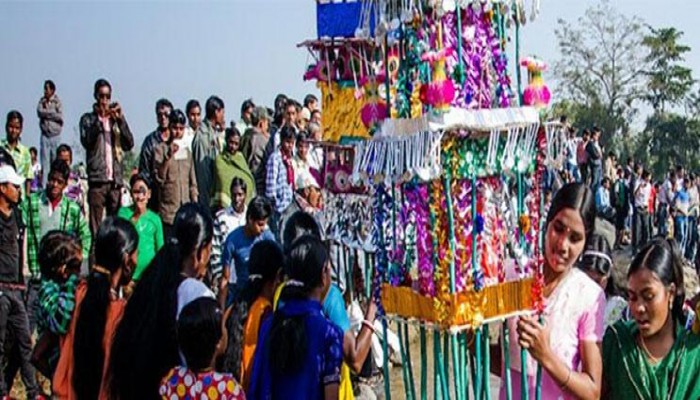Tusu Puja – A Timeless Tradition of Devi Worship in Eastern India Part-2
- In History & Culture
- 11:08 AM, Jan 23, 2021
- Ankita Dutta
Famous for its rich culture, Jharkhand is home to a large number of vibrant fairs and festivals celebrated all the year round in myriad ways. Tusu Puja is mostly celebrated in the area between Bundu, Tamar, and Raidih areas of Jharkhand beginning from the middle of November till almost mid-December (according to the Bengali calendar, from the last day of Aghrahayan Sankranti till the last day of the month of Paus) by the Kurmis and various other janajati communities. This region of Jharkhand boasts of an illustrious history during India’s struggle for freedom against the British colonial rule. Ranchi and Bokaro districts of Jharkhand are especially famous for the Tusu Puja festivities, where it is celebrated as a harvest carnival with a traditional fervour. The small and moderate-scale hotels close down their shops a few days ahead of the festival, as most of the labourers go on a holiday.
In a few areas of Jharkhand, married women do not worship Tusu even today. It is mainly the girls who take the entire responsibility of performing all the rituals of the festival. Pre-pubescent girls prepare beautiful idols of Tusu Devi and worship her every morning in their homes with a prasad of puffed rice, jaggery and curd while narrating the story of Tusu Devi. It is because young virgin girls are believed to be symbolic of a fresh harvest, and it is in this way that the fertility of women is closely associated with the fertility of the land. Menstruating women are strictly debarred from taking part in the rituals.
Tusu is a harvest festival in Jharkhand with paddy and rice being the chief components of the celebrations. The last paddy stack that remains after all the paddy stacks have been cut off from the field is called dinimai, which is believed to represent Tusu Devi. The head of the family brings the dinimai from the agricultural field and on that very same day, the young girls perform the rituals of pran-pratishtha of the Devi in their homes.
The murti of Tusu Devi has no structure in most places of Jharkhand. A kulungi (hole) is first made in the wall to place the murti. The main ingredient from which the idol is made is tush or rice husk. A few grains of rice and flowers are placed inside the kulungi which is worshipped by the unmarried girls for the entire month in the altars of the walls of their homes. They decorate the walls and floors of their houses with alpona. Choudal/choural or chaturdala which symbolises Surya Devta (the Sun), is used for the immersion of the murtis on the last day of the festival. It is a lightweight cylindrical structure resembling the vimana of a temple, hand-crafted from wood, bamboo, hay, and jute sticks with bits of coloured paper and other decorative items stuck to it. Locals could be seen depicting different characters from our epics and merrily dancing to drumbeats on the streets during the immersion ceremony.
All the necessary paraphernalia used for the worshipping rituals are placed inside the choudal, which include one dhakon (burnt earthen bowl), rice husk, alochaal (boiled rice seeds), fried white rice, durba (scutch grass), the badu flower which grows on the sal tree, mustard seeds, gendu phool (marigold flowers), radish flower, and one goboro (cow-dung ball). Since goboro symbolises purity and fertility of the land, it is believed that the worship of Tusu is closely related to the fertility cult.
Rice and parched rice (Khoi) are being thrown over the choudal before its immersion. The decorations on the choudals are collected by the women for their own use. Young girls mostly use these colourful materials of the choudals to decorate their hair. Sometimes, two different murtis representing the male and female reproductive organs are made in many places of Jharkhand. These are worshipped everyday by the girls with profound devotion by offering them with corn and marigold flowers. Afterwards, the murtis are carried by the women on chourals over their heads in a celebratory procession for immersion in the river, pond or any other water-body located nearby. Because the river banks are used as places of mass congregation, they also serve as ideal grounds for traders who assemble at the place to sell a diverse range of products.
In this way, the Tusu Parab plays a major role in sustaining the rural economy by ensuring a continuation of different art and craft practices. This convergence of the rural economy and rituals related to agriculture is what makes the Tusu festival a fascinating experience.
Here, it is important to mention that the choural is not Tusu (the unmarried girl) herself, but the metaphor of a vehicle (a kind of palanquin decorated with flowers). The choural is made in various eye-catching patterns with beautiful decorations. Earlier, these were made at home by chaste virgin girls. Nowadays, they are sold in the market at varying prices. Chou means four sides while Ural implies flying; thus, choudal means someone who can fly in all directions and at the same time. Literally, choudal represents the rays of the sun which spread out in all directions. Its design resembles a chariot (rath) pulled during the festival of Rath Yatra at Jagannath Mandir in Puri, Odisha. However, unlike the rath, the choudal has no wheels. Depending upon its size, the choudals are either carried by hand or supported on shoulders by a team of bearers.
Symbolically speaking, the choudal is the vehicle on which the girl leaves from her maternal home for her husband’s home where she will consummate her marriage and usher in a new life. This journey and departure of the girl also signals the end of the harvest season and the completion of the agricultural cycle. Nowadays, colourful choudals are sold at the haats (market areas). Extraordinarily beautiful choudals having the height of a 2-3 storied building and supported by a rope are especially manufactured for competitions.
In the ancient period, it was a matter of utmost pride for the Kurmis to marry off their daughter soon after she started menstruating. This was also meant to convey a larger message to the community that her body was now physically capable of bearing a child, at a time when having a larger family of several children was considered to be an asset. The immersion of Tusu in the waters signifies the mixed feelings of a newly-married girl who leaves behind the comforts of her parental home and the emotions associated with it for a completely new place, a new family and new people. Since a grain or a seed can flourish only after it gets enough water, similarly, a girl can become pregnant only after consummating the marriage with her husband at her in-laws’ place. Hence, Tusu is seen as the harbinger of new life and prosperity. The women also take a sacred Makar Sankranti dip in the river after the immersion of the choudals is finally complete.
Among the Kurmis, the word Tusu represents a combination of Tu meaning maturity, and Su meaning husband, referring to the association of crop with water. A Bengali essay titled Tusu Parab (‘The Tusu Festival’) by Sripada Mahato describes the Tusu Parab of the Kurmis of Jharkhand in a vivid detail.
Most of the Kurmis of Jharkhand and Chhattisgarh worship Tusu Devi as the ‘Goddess of Crops’. They are of the opinion that the word Tusu has been derived from the etymological roots Tui meaning ‘the highest position of the sun’ and Su meaning ‘the sun’. Hence, Tusu means the highest or final position of the sun. Hence, worship of the sun is one of the major rituals of Tusu Puja. It is because seed germination which is very important for the agricultural cycle, cannot take place in the absence of sunlight. Our ancestors were very much aware of the changes in the movement of the sun at this time of the year, which was celebrated by them in their own distinct and unique ways. In this sense, Tusu Puja is not merely a local festival observed by the janajatis of a few states of our country that is Bharat. Tusu Devi is worshipped to solemnise the power of the sun (symbol of divinity and wisdom) in agriculture and cultivation of crops. Various social organisations in Jharkhand distribute tilkut, jaggery, sesame seeds, rice grains, cooking oil, and clothes among the Kurmis on the eve of Tusu Puja.
Women have a much more significant role to play than men in almost all the rituals of Tusu Puja, including seeding, painting the alpona, pran-pratishtha of Tusu Devi with tush, and grinding rice with cow-dung balls and one small stick of paddy.
In a few parts of Jharkhand and Shantiniketan in West Bengal, huge fairs called Poush Mela or Tusu Mela are organised as a mark of Tusu Puja, where cock fights have become a ritualistic event. It is known as Makara Mela in Mayurbhanj, Keonjhar, Kalahandi, Koraput, and Sundargarh districts of Odisha. Entry tickets are being sold out in huge numbers. Gaudily dressed men and women pour in large numbers from all directions, both individually and as well as in groups, singing songs loudly and carrying Tusu idols of various moulds in their hands. Murti-making competitions and Matka Phod competitions are one of the most attractive events of these week-long fairs. Different sports competitions and various forms of entertainment including gambling and maut-ka-kuan (well-of-death) attract huge crowds at these fairs. Cultural activities like songs, drama, and different kinds of dances of the janajatis such as Nachni, Chhau, etc. are also organised. Prizes in galore are distributed to the winners of the competitions.
These Melas are a traditional part of the Tusu Utsav. They are organised with an aim of bringing the traditional culture of the janajatis and local artisans and their skills to the limelight. Besides food stalls, brightly coloured shops selling decorative and rare symbolic artefacts, agricultural implements, toys, dress materials, wooden furniture and household items, stone slabs (sil-nora) for grinding spices, musical instruments, and other handloom and handicraft items, etc. manufactured by local craftsmen of the area are put up in these fairs.
Numerous songs which are sung by women in honour of Tusu Devi are a reflection of the traditional cultural heritage of the janajatis. The innumerable Tusu Geets have remarkably contributed towards strengthening and enriching the culture of Purulia district and the surrounding regions of Rarh Bengal. These are songs of fertility, praying to Mother Earth for a rich and prosperous harvest. They are known by different names in different places of Rarh and are sung in different ways with a mixture of lyrics, articulations and tunes. But the overwhelming influence of Santhali lyrics and tunes are clear in the Tusu songs of Purulia region in Bengal. These are beautiful extempore songs which, if published, can significantly enhance the literary heritage of the janajatis. But in the name of ‘folk literature’ by an agenda-peddling Communist academia, they have always been categorised as a completely separate entity and hence kept aside from the so-called ‘mainstream literature’.
Tusu songs are not lengthy and are the products of oral transmission of local histories through several generations. Their content varies from the ups-and-downs of life and its bitter-sweet experiences to the interactions of man with his surrounding environment which includes plants, animals, birds, etc. Various socio-political, economic, cultural, and educational issues too, are embedded in these songs which unravel themselves in different layers when sung. In other words, the Tusu Geets have nowadays transcended their ritualistic purposes and are used as tools of protest, and as well as political and commercial songs.
Tusu songs constitute an important part of the popular culture of the janajatis, based as they are on different stories from our historical texts (the Ramayana and the Mahabharata) and the Puranas, contemporary political and as well as local issues, etc. Through simple expressions and usage of language, they portray the different facets of life and people’s ways of living, besides the rich cultural heritage of the janajati communities.
Tusu Puja in Assam is a grand socio-cultural and religious celebration, confined as it mainly to the janajatis of the tea garden areas in Upper Assam, who have a distinct and unique culture of their own. It coincides with Magh Bihu and is thus declared as a regional public holiday every year by the Government of Assam. The rich culture and traditions of the tea garden janajatis of Assam is an integral and indispensable part of the overall Assamese culture and heritage, encompassing diverse aspects of its society such as language and literature, way of life, work culture, food habits, politics, society and economy, etc. They have contributed in their own unique ways towards strengthening the overall socio-cultural fabric and ethno-cultural milieu of the state of Assam, and the formation of a greater Assamese identity.
Besides Tusu Puja, they also celebrate Durga Puja, Kali Puja, Manasa Puja, Shivratri, Holi, Karam Puja, Maroi Puja, Sohrai Parab, etc. as per their own traditional customs and systems. Most of their festivals are centred around the womenfolk of their community which also reflects a lot about the history, societal values, and aesthetic lives of the tea garden labourers.
In Assam, there is famous narrative associated with the festival of Tusu Puja. It is believed that Tusu or Rukmini was one of the beautiful daughters of the Kurmi king of present-day Gujarat. The Mughals, however, were desperately trying to annex his kingdom into their dominions through a wholesale conversion of the entire population. Instead of surrendering, the king chose to flee and sought refuge in the court of Birbal, the King of Punjab. It was during those days that Tusu and Sitaram, the son of Birbal, fell in love with each other. But the Mughals were baying for the blood of the Kurmi king and Tusu’s father, which became a factor of obstruction in their relationship. So, they ran away from Punjab as well to the deep and dense jungles of Assam. It was here in Assam that the Chawtal and Bhumij janajatis residing in the Valley of the Brahmaputra came to know about Tusu and Sitaram’s relationship and helped the love-birds get married under the initiative of the Bhumij King.
But, in a quite unfortunate turn of events, Tusu’s husband died just a few days of their marriage. Unable to bear the tragic loss, a distraught Tusu self-immolated herself by willingly sitting atop the funeral pyre of her dead husband, thus becoming sati. It was from then onwards that the Kurmis, Chawtals, and Bhumijs of Assam began to worship Tusu as a “pure soul”. With the gradual passage of time, she came to be worshipped as Ma Sita and Ma Savitri. Many of the janajati communities also compare Tusu with Ma Kali and Ma Durga.
Sculptors carve beautiful statues of Tusu Devi on the occasion, and people beautifully decorate them with mud and fresh flowers on the first day of the festival which is known as Uruka. Young boys and girls carry the statue from house-to-house singing the praises of her glory and unmatched love and dedication towards her husband. Many a times, the murti is placed at a common place of worship, such as an open field or a playground, where the locals offer their prayers throughout the day. It is an extremely pleasing sight to see the young girls of the community elegantly decked up in their traditional attire and dancing to the tunes of the Madal. Tusu Devi symbolises the virtues of kindness, love and sacrifice and happens to be the favourite Goddess of the tea garden janajatis of Assam. Tree plantation drives and book-release functions are organised in several places of Upper Assam as a mark of the occasion. Different competitions among students are also organised such as drawing competitions, Tusu dance-song competitions, and essay-writing competitions.
Just like in other parts of India, both til and gur are the two most important ingredients of the various traditional dishes that are prepared on the occasion of Tusu Puja in Assam, also known as Til Sankranti. At the end of the ceremonies, the idol is immersed in the flowing waters of the Brahmaputra. There is a traditional custom in which many devotees forge bonds of new friendship on this day, with the river as a witness to their promise.
It may be recalled here that the discovery of tea in Assam during the mid-19th century had resulted in populating the state with people from different janajati communities such as Ho, Kol, Chawra, Santhal, Munda, Chaotal, Oraon, Kharia, Khond, Gond, Guwal, Karmakar, Malpaharia, Tanti, Tasa, etc. They were largely brought in through deceit from the present-day Chhotanagpur region of central India, besides Odisha, Andhra Pradesh, and West Bengal to work as labourers at a very low wage in the large British-owned tea estates. Factors such as the interior locations of the tea gardens and extremely limited interactions with the outside world, language barriers, and dissimilarity in physical appearances, etc. were some of the primary factors which made them an insulated lot from the rest of the population in Assam. They had embraced Assam as their homeland since a long time back, and assimilated themselves with the Assamese culture and ethos. Today, Christianity is emerging as a popular religion among these janajatis.
There are approximately 800 tea gardens spread across seven different districts of Upper Assam – Jorhat, Golaghat, Sibsagar, Dibrugarh, Tinsukia, Lakhimpur, and Dhemaji. A ride through the highway from Dibrugarh to Makum in Tinsukia and beyond, amid a very powerful aroma of freshly-plucked tea-leaves, is a beauty to behold in itself.
Tusu Puja was earlier celebrated for the entire month of Paus. But, in the recent years, due to the constraints of time and changing circumstances, the celebrations have been reduced to only two days of the month, i.e. the previous day of Paus Sankranti (the 29th day of Paus) which is observed as jagoron (awakening), and the next day on which the festivities formally come to an end. With the changing times, a traditional folk festival like Tusu Puja is also changing its trends with the influence of external factors. Commercialisation has crept in and competitions have taken precedence over the religious rites and rituals of worship in many places. Memories of Tusu poetry/songs are today getting replaced by Bollywood songs and DJ dance numbers. While earlier Tusu Puja was celebrated as a household affair, nowadays elaborate choudals are especially prepared for taking part in the competitions, where winners receive cash prizes.
It is mainly because of these competitions that the choudals have become bigger and brighter, attracting large crowds of people at the melas. Winning these competitions have become a matter of great prestige among the choudal makers. Photographers eager to click pictures of the Tusunis and young girls in different poses are quite a common sight in the tea garden areas of Chabua and Makum in Upper Assam on the occasion of Tusu Puja.
Tusu Puja is also a time for celebration among the Hindus residing in the Char Meghna region, a border area between India and Bangladesh under Hogolberia Police Station in Nadia district of West Bengal. It is almost a month-long commemoration of Tusu Devi by women mostly belonging to the Kudumi community. They gather every evening at a particular place in the village and sing verses dedicated to a girl named Tusu and her struggle to save her dignity from the Islamic invaders during the mid-18th century. Hence, festivals such as Tusu Puja are also indicative of a tradition of extreme aversion posed by the people of our country against a barbaric foreign force of religious bigots.
References:
- Alam, Raja. (2018). Festival of Tusu: An Introduction. https://www.sahapedia.org/festival-of-tusu-introduction
- Dan, Koushik. (2018). People, Festival and Culture: A Study on Jangal Mahal of West Bengal. International Journal of Creative Research Thoughts, Vol. 6, No. 1, pp. 2158-2165.
- Deb, Debashree. (2017). Sociological Analysis of Tusu Songs. Gandharvam: A Referred Journal of Sachin Debbarman Memorial Govt. Music College, Vol.1, No. 2.
- Ganai, Barun. (2017). Folk Tourism Elements in Rarh Bankura, West Bengal – A Descriptive Study. International Journal of Research and Analytical Reviews, Vol. 4, No. 3, pp. 203-206.
- Goswami, Praphulladatta. (2015). Festivals of Assam. Anundoram Borooah Institute of Language, Art and Culture. North Guwahati: Assam.
- Kundu, Satabdi. Islam, Mohidul. Nandi Kumar, Shyamal. (2016). Traditional Festivity of Tusu Puja: An Anthropological Appraisal. Journal of the Anthropological Survey of India, Vol. 65, No. 2, pp. 333-340.
- McDaniel, June. (2002). O Tusu Ma: Self-expression, oral history, and social commentary for the Jharkhand Goddess. International Journal of Hindu Studies, Vol. 6, No. 2, pp. 175-197.
- Mohanta, Basanta K. (2011). Tusu Festival of the Kudumis of Northern Orissa: Origin and Causes. Journal of Sociology and Social Anthropology. Vol. 2, No. 1, pp. 23-29.
- Sanyal, Pinki Biswas. (2019). Tusu: A Harvest Festival of Chhotanagpur. https://www.google.com/amp/s/pinkibiswassanyal.wordpress.com/2019/09/02/tusu-a-harvest-festival-of-chhota-nagpur/amp/
- https://www.google.com/amp/s/nenow.in/north-east-news/assam/actress-mahika-sharma-promotes-festival-assam-tea-tribes.html/amp
- https://indiavivid.com/jhumur-the-tribal-dance-of-assam/
- https://www.google.com/amp/s/www.newindianexpress.com/states/odisha/2013/jan/15/kudumis-kurmis-worship-tusu-devi-443251.amp
- https://www.google.com/amp/s/www.newindianexpress.com/states/odisha/2010/jan/14/kudumi-mohantas-worship-tusu-devi-160688.amp
- https://www.dailypioneer.com/2020/state-editions/tribals-gear-up-for-tusu-festival.html
- https://isharethese.com/tusu-dance-folk-song-sundarbans/
To all my beautiful tea garden friends, brothers and sisters from Assam among whom I have grown up.
Image Source: Cheif Minister of Jharkhand
Disclaimer: The opinions expressed within this article are the personal opinions of the author. MyIndMakers is not responsible for the accuracy, completeness, suitability, or validity of any information on this article. All information is provided on an as-is basis. The information, facts or opinions appearing in the article do not reflect the views of MyindMakers and it does not assume any responsibility or liability for the same.







Comments